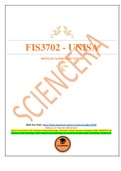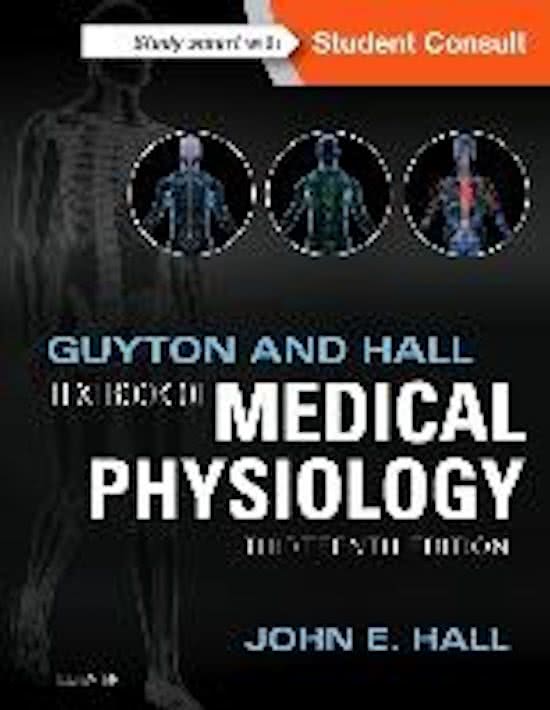FIS3702 - UNISA
NOTES BY SCIENCCERA TUTORS
,QUESTION 1
1.1 Tabulate the functional parts of the circulatory system. Include at least one function and defining characteristic of
each. (14)
Functional
Function Defining Characteristic
Part
Consists of four chambers: two atria and
Heart Pumps blood throughout the body
two ventricles
Have thick, muscular walls to handle
Arteries Carry oxygenated blood away from the heart
high blood pressure
Have valves to prevent blood from
Veins Carry deoxygenated blood back to the heart
flowing backward
Facilitate exchange of nutrients, gases, and Have very thin walls to allow for
Capillaries
waste products between blood and tissues diffusion
Red Blood Contain hemoglobin, a protein that
Transport oxygen from the lungs to the tissues
Cells binds to oxygen
White Blood Part of the immune system and can
Help fight off infections and diseases
Cells differentiate into different types
Formed from megakaryocytes in bone
Platelets Help form blood clots to stop bleeding
marrow
1.2 Briefly discuss the three basic principles that control circulation to tissues. (6)
The three basic principles that control circulation to tissues are:
Autoregulation: This principle refers to the ability of tissues to regulate their own blood flow by changing the diameter
of their blood vessels in response to changes in metabolic demand. For example, when a tissue requires more oxygen
and nutrients, its blood vessels can dilate to increase blood flow, and when the tissue's needs decrease, the vessels can
constrict to reduce blood flow.
Neural Regulation: The nervous system can also control circulation to tissues by altering blood vessel diameter through
the release of neurotransmitters. For example, the sympathetic nervous system can cause blood vessels to constrict,
which reduces blood flow, while the parasympathetic nervous system can cause vessels to dilate, which increases blood
flow.
Hormonal Regulation: Hormones, such as adrenaline and noradrenaline, can also regulate circulation to tissues by
altering blood vessel diameter. For example, during times of stress or exercise, the adrenal glands release adrenaline,
which causes blood vessels to constrict, redirecting blood flow to vital organs. Similarly, hormones like vasopressin can
cause blood vessels to constrict, while others, like nitric oxide, can cause them to dilate.
,QUESTION 2
Compile a table to differentiate between the two types of nervous control of the cardiovascular system. [10]
Characteristic Sympathetic Nervous System Parasympathetic Nervous System
Thoracic and Lumbar regions of the spinal
Origin cord Brainstem (medulla oblongata)
Neurotransmitter Releases norepinephrine Releases acetylcholine
Effect on Heart Rate Increases heart rate Decreases heart rate
Effect on Force of
Contraction Increases force of contraction Decreases force of contraction
Effect on Blood Vessels Vasoconstriction (constricts blood vessels) Vasodilation (dilates blood vessels)
Effect on Blood Pressure Increases blood pressure Decreases blood pressure
Activated during "rest and digest"
Response to Stress Activated during "fight or flight" response response
Increases cardiac output and blood Decreases cardiac output and blood
Overall Effect pressure pressure
QUESTION 3
Describe the flow of current through the heart by drawing an ECG tracing/wave form representing a single cardiac
cycle. Link each section of the wave form to the electrical and mechanical events occurring in the heart. [10]
, During a single cardiac cycle, the flow of current through the heart can be represented by the ECG wave form. The ECG
wave form consists of several sections, each corresponding to a specific electrical and mechanical event in the heart.
P wave: The P wave represents atrial depolarization, which is the electrical activation of the atria. This is followed by
atrial contraction, which leads to the filling of the ventricles.
QRS complex: The QRS complex represents ventricular depolarization, which is the electrical activation of the ventricles.
This is followed by ventricular contraction, which leads to the ejection of blood from the ventricles into the arteries.
T wave: The T wave represents ventricular repolarization, which is the electrical recovery of the ventricles. This is
followed by relaxation of the ventricles and the filling of the heart with blood again.
PR interval: The PR interval represents the time it takes for the electrical impulse to travel from the atria to the
ventricles. It begins at the start of the P wave and ends at the start of the QRS complex. The normal PR interval ranges
from 0.12 to 0.20 seconds (or 3 to 5 small squares on an ECG).
TP segment: The TP segment is the flat line that follows the T wave and represents the period of time between
ventricular repolarization and the next heartbeat. During this time, the ventricles are relaxed and filling with blood.
ST segment: The ST segment represents the period of time between ventricular depolarization (end of the QRS complex)
and ventricular repolarization (beginning of the T wave). It is normally a flat line that is at the same level as the baseline.
Changes in the ST segment can indicate myocardial ischemia, injury, or infarction.
QT interval: The QT interval represents the time it takes for the ventricles to depolarize and then repolarize. It begins at
the start of the QRS complex and ends at the end of the T wave. The length of the QT interval varies with heart rate and
age, and it can be affected by certain medications and electrolyte imbalances. A prolonged QT interval can increase the
risk of ventricular arrhythmias, including torsades de pointes.
The electrical events of the heart precede the mechanical events. The electrical activation of the atria leads to atrial
contraction, which is followed by the electrical activation of the ventricles and ventricular contraction. Ventricular
repolarization then occurs, which leads to ventricular relaxation and the filling of the heart again.
QUESTION 4
Cardiac output is known as the volume of blood pumped by the heart per minute, and although the normal cardiac
output is usually around 5.6 L/min, this value is not static. Analyse each of the variables that determine cardiac output
as well as factors affecting these variables in order to demonstrate their ability to alter one’s cardiac output. [10]
ardiac output is determined by two variables: stroke volume and heart rate. Stroke volume is the volume of blood
ejected by the heart with each beat, while heart rate is the number of beats per minute. Cardiac output is calculated by
multiplying stroke volume and heart rate.
There are several factors that can affect stroke volume and heart rate, and thus alter one's cardiac output. These factors
include:
• Preload: Preload is the degree of stretch on the heart muscle fibers at the end of diastole, which is the resting
phase of the cardiac cycle when the heart is filling with blood. An increase in preload can lead to an increase in
stroke volume and cardiac output. Factors that increase preload include increased blood volume and venous
return.
• Afterload: Afterload is the resistance the heart must overcome to eject blood from the left ventricle into the
systemic circulation. An increase in afterload can lead to a decrease in stroke volume and cardiac output. Factors
that increase afterload include increased arterial resistance, hypertension, and stenosis of the aortic valve.





